
Platform Conference Wrap Up
By: Van Smith
Date: February 1, 2002
Last week we provided first day coverage of the Platform Conference, one of the computer industry's premier events. Although conference-to-conference attendance was flat, considering the economic conditions this might indicate that the industry-wide downturn has bottomed out. Certainly the attendees were livelier than ever and the Platform Conference had the hustle and bustle of a boom time crowd.
- Introduction, AMD: Thoroughbred pictures, Mobile initiatives, small form factor, heat pipes and more.
- Paradise Computing: VIA's Eden initiative
- Memories: QBM, DDR-II, and Rambus too... and more.
- nVidia: Mobile AGP and AGP risers
- Via VIA: A big presence
- HyperTransport: Taking off...
- And more...: The Case is Clear, Info PC's, etc.
Plus, don't miss our first day report where we talk Hammer, memory, performance initiatives and the inexpensive nVidia nForce 415-D.
===================================
AMD Shows Thoroughbred
Alleged photos of AMD's next generation Athlon XP have been popping up in dark corners of the Internet recently. In a couple of their Platform Conference presentations, AMD showed pictures of the AMD Athlon Model 8, also known as "Thoroughbred." Based on a 0.13 micron copper process, the Thoroughbred is expected to ramp to considerably higher speeds than the current Athlon XP "Palomino" core based on a 0.18 micron copper process.
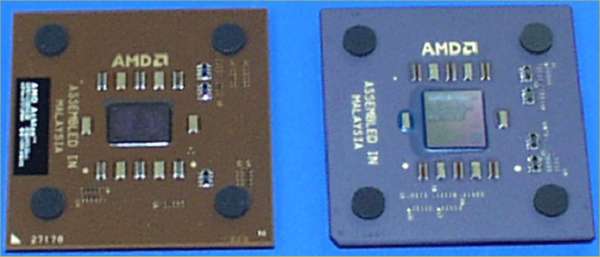
Thoroughbred on the left, Palomino on the right.
In the picture above, the Thoroughbred is shown in the brown organic package, while the Palomino is in ceramic. Note that not only is the Thoroughbred die much smaller (80 mm2 versus 129 mm2), but is shaped much differently suggesting that perhaps more than a mere die shrink is at work. This lends credibility to rumors claiming Thoroughbred will extend AMD's already considerable lead over Intel in the IPC ("Instructions Per Clockcycle" used to denote processing efficiency) race.
It is worth noting here that AMD's organic package used with the Athlon XP is thinner than the old ceramic package. Although this will diminish by about a pound the force placed on the processor die by CPU coolers, AMD states that this will be "transparent" for coolers that follow its thermal solution guidelines.

OPGA is thinner by about 0.30mm.
AMD also showed a picture of Thoroughbred in AMD's new organic micro-PGA mobile packaging:
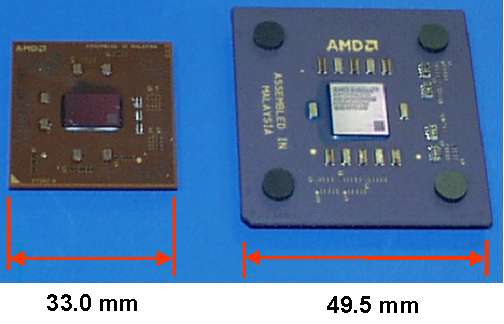
Thoroughbred in micro-PGA on the left.
===================================
AMD Moves on Mobile
Speaking of AMD and the mobile market (which includes primarily laptops), the upstart chipmaker released a chart showing the explosive market share growth it experienced in this area last year.
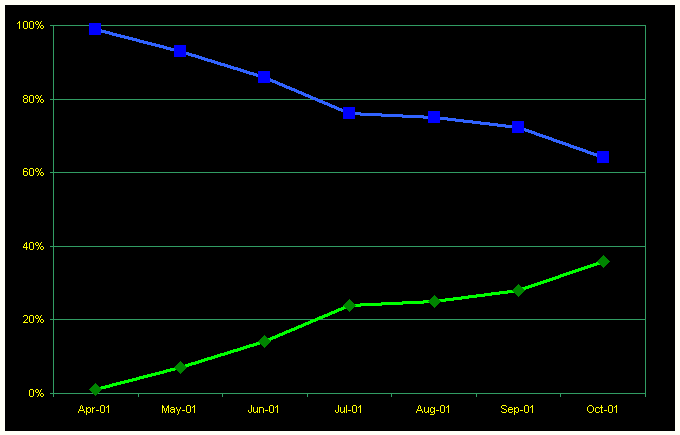
AMD, in green, is quickly eating into Intel's
mobile market share, in blue.
It is interesting to note in AMD's Mobile Roadmap below that not only will the SOI ("Silicon-On-Insulator," a technology that reduces current loss allowing chips to demand less power and therefore to elevate clock speed potential) mobile version of Athlon dubbed "Barton" appear later this year, but AMD has aggressively scheduled a 0.09-micron version Hammer for laptops late next year.

AMD's Mobile Roadmap
AMD has introduced two processor sockets for mobile markets. The first is a low profile version of Socket-462.
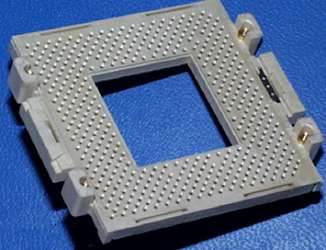
Low-Profile Socket-462
The micro-PGA Thoroughbred shown above fits in Socket-563 shown below:
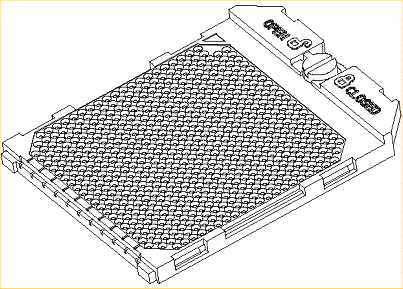
Socket-563
Notice that the chip is secured in the socket by using a screwdriver to rotate the locking mechanism.
===================================
PowerNow!
The fastest mobile Athlon 4s and Durons have worst case maximum power dissipation rates of around 25W. AMD has been able to stay at this level by reducing the voltages to faster chips.
When does worst case power draw occur? AMD presented the following chart to illustrate the loads from a few different applications.
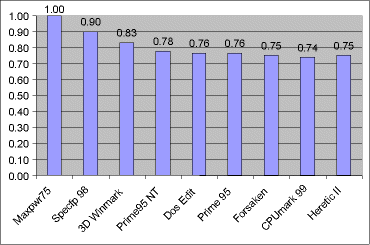
Maxpwr75 is an AMD developed internal testing program that pushes the Athlon to its maximum current usage. Although this program is not publicly available in order to reduce promulgation of thermal viruses, AMD stated that CPUBurn, a free testing application, is also used internally and approaches Maxpwr75 in terms of power utilization.
It is interesting to see that DOS Edit generates as much processor heat as Prime95, a test some websites have used to stress test CPUs.
Similar to Transmeta's LongRun and VIA's LongHaul, AMD's PowerNow! is a sophisticated power management technology used to dynamically regulate CPU clock speed in voltage according to application demands.
PowerNow! is much more sophisticated than Intel's SpeedStep. A comparison is shown below.
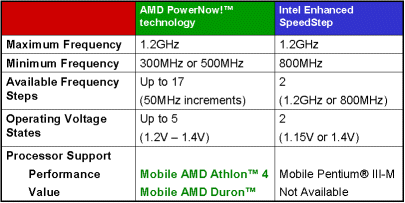
Although Enhanced SpeedStep can now adjust dynamically to load, it can only toggle between two states. PowerNow! enables up to 17 frequency steps and five voltages.
The impact of PowerNow! is shown in the AMD chart below for a 1GHz Athlon 4 laptop. Interestingly, even power consumption during DVD playback is significantly reduced. Also notice that the processor never approaches its worst case maximum of over 20W even when PowerNow! is turned off.
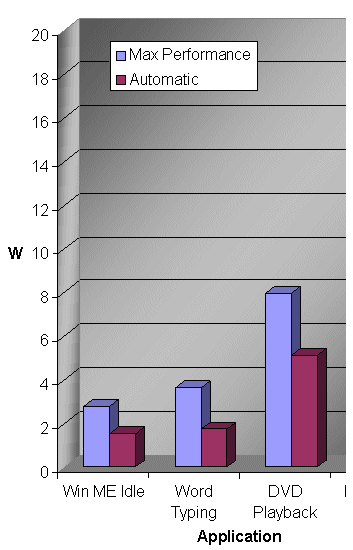
Impact of PowerNow! on a 1GHz Athlon 4.
===================================
Heat Pipes
The use of higher speed AMD Athlon 4s and Intel Pentium IIIs in laptops has led to the use of fairly exotic cooling solutions. We have seen "heat pipes" in Dell Intel Tualatin-based notebooks, where the CPU cooler looks more like an automobile radiator than what one sees in most computers. AMD discussed similar devices for Athlon 4 notebooks.
Below is a heat pipe-based CPU cooler shown in AMD's presentation.
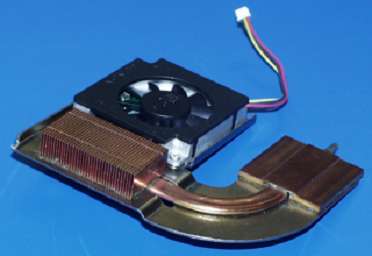
The CPU would be under the copper plate on the right. This is more clearly shown in the illustration below.

===================================
Look Ma, No Fans!
From the looks of things at the Platform Conference, so called Small Form Factor Quiet PC's are gaining the attention of many. The innards of a prototype Athlon system was shown in an AMD presentation on building Small Form Factor PCs.
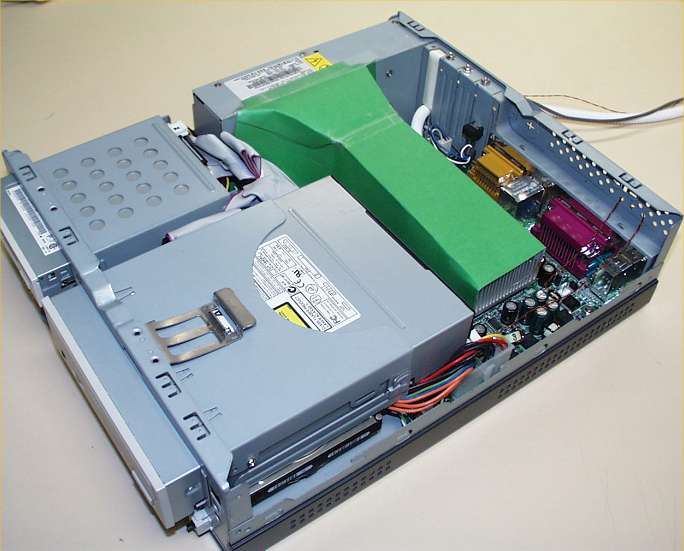
In this system, the CPU is passive cooled. Chips up to 35W can be supported in this tiny setup.
===================================
- Introduction, AMD: Thoroughbred pictures, Mobile initiatives, small form factor, heat pipes and more.
- Paradise Computing: VIA's Eden initiative
- Memories: QBM, DDR-II, and Rambus too... and more.
- nVidia: Mobile AGP and AGP risers
- Via VIA: A big presence
- HyperTransport: Taking off...
- And more...: The Case is Clear, Info PC's, etc.
Plus, don't miss our first day report where we talk Hammer, memory, performance initiatives and the inexpensive nVidia nForce 415-D.
===================================
Pssst! We've updated our Shopping Page.
===================================